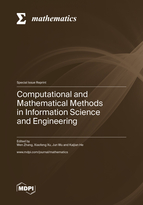Computational and Mathematical Methods in Information Science and Engineering
A special issue of Mathematics (ISSN 2227-7390). This special issue belongs to the section "Engineering Mathematics".
Deadline for manuscript submissions: closed (1 July 2023) | Viewed by 41463
Special Issue Editors
Interests: data mining; machine learning; business intelligence
Special Issues, Collections and Topics in MDPI journals
Interests: Industry 4.0; intelligent transportation systems and logistics; big data analytics
Special Issues, Collections and Topics in MDPI journals
Interests: supply chain management; big data and AI applications; game theory; system dynamics
Special Issues, Collections and Topics in MDPI journals
Interests: forecasting; time series; intelligent energy management; big data analytics; wavelet analysis
Special Issues, Collections and Topics in MDPI journals
Special Issue Information
Dear Colleagues,
In this booming information age, massive amounts of complicated and diverse data resources are being produced over time. Information science and engineering is one of the most attractive research fields due to the need to collect, store, analyze, and visualize these complicated and diverse data to address the challenges of human beings to date. In this area, computational and mathematical methods provide effective tools to handle data and information for pattern recognition, knowledge discovery and utilization, and decision-making for complex problems.
This Special Issue focuses on recent advanced computational and mathematical methods in information science and engineering to address problems that occur in practice, including theory and potential applications. Topics include, but are not limited to, the following:
- Computational intelligence theory and applications
- Intelligent modeling, control and optimization
- Complex network modeling
- Heterogeneous data mining and fusion
- Big data analytics and artificial intelligence
- Knowledge discovery, inference and optimization
- Complicated high-dimensional data representation and visualization
- Classification and clustering models in applications
- Heuristic intelligence optimization methods
- Deep learning methods
- Open-source software and E-commerce
- Information systems
- Intelligent manufacturing and industry 4.0
- Intelligent transportation systems and logistics
- Recommendation systems
- Knowledge management processes and systems
- Intelligent tourism and intelligent education
Prof. Dr. Wen Zhang
Prof. Dr. Xiaofeng Xu
Prof. Dr. Jun Wu
Prof. Dr. Kaijian He
Guest Editors
Manuscript Submission Information
Manuscripts should be submitted online at www.mdpi.com by registering and logging in to this website. Once you are registered, click here to go to the submission form. Manuscripts can be submitted until the deadline. All submissions that pass pre-check are peer-reviewed. Accepted papers will be published continuously in the journal (as soon as accepted) and will be listed together on the special issue website. Research articles, review articles as well as short communications are invited. For planned papers, a title and short abstract (about 100 words) can be sent to the Editorial Office for announcement on this website.
Submitted manuscripts should not have been published previously, nor be under consideration for publication elsewhere (except conference proceedings papers). All manuscripts are thoroughly refereed through a single-blind peer-review process. A guide for authors and other relevant information for submission of manuscripts is available on the Instructions for Authors page. Mathematics is an international peer-reviewed open access semimonthly journal published by MDPI.
Please visit the Instructions for Authors page before submitting a manuscript. The Article Processing Charge (APC) for publication in this open access journal is 2600 CHF (Swiss Francs). Submitted papers should be well formatted and use good English. Authors may use MDPI's English editing service prior to publication or during author revisions.
Keywords
- computational intelligence
- mathematical modeling
- data mining
- text/document analysis
- optimization
- big data analysis
- deep learning
- complex networks
- software defects detection
- e-commerce
- social network
- information systems
- recommendation systems
- intelligent logistics
- intelligent energy management
- intelligent education
- intelligent tourism







